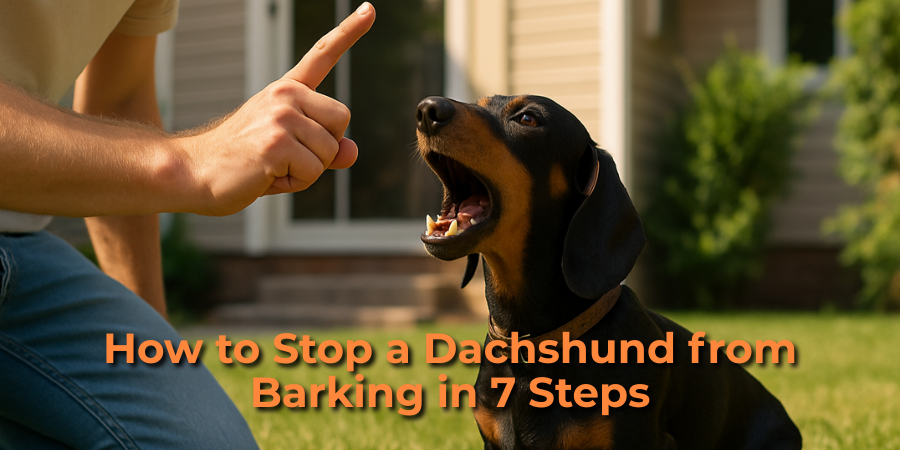How to Stop a Dachshund from Barking in 7 Steps
Dachshunds were bred as hunting dogs, and it’s in their heart to bark — often loudly for their small size. They love to sound off at changes in their environments, and their sensitive nature increases the likelihood of excessive barking. Many owners face this issue, and while I had read up on it prior to getting my puppy, I still underestimated how noisy the breed could be.
Though barking can feel like an unavoidable trait, with the right steps, you can help stop your dachshund from barking excessively. In this blog post, we’ll learn practical tips to quiet your pup and prevent or eliminate the nuisance—making life easier for both owners and their dogs.

How to Stop a Dachshund from Barking in 7 Steps – Short Answer
To stop a Dachshund from barking, identify the root cause—such as boredom, anxiety, or territorial behavior—and address it through consistent training. Use commands like “quiet,” provide daily exercise, and reward calm behavior to reinforce good habits.
Why Do Dachshunds Bark So Much?
To stop your dachshund from barking excessively, you first need to understand their barking triggers. Like many breeds, dachshunds may bark out of boredom, anxiety, territorial behavior, or simply to get attention. Recognizing the root cause is the first step to addressing the problem.
If your pup is barking because they’re anxious or bored, changing their routine or adding stimulation can help. But if it’s territorial, you’ll need a different approach. Whatever the reason, once you identify it, you can take the right steps to solve the underlying issue and enjoy more peace at home.
Step 1 – Address the Root Causes
Excessive barking in Dachshunds often comes from boredom, anxiety, or built-up energy. Without proper exercise and mental stimulation, your dachshund may resort to barking to express frustration. Tackling these causes directly can lead to a calmer, quieter dog.
Ensure Daily Physical Activity
- Take your Dachshund for at least one brisk 30-minute walk daily.
- Let them sniff and explore to engage both body and mind.
- From experience, our boy barks much less after a good walk.
Keep Them Mentally Stimulated
- Use treat puzzles or a stuffed Kong to keep them busy when alone.
- Rotate toys to prevent boredom and offer new challenges.
Create a Safe, Comfortable Space
- A crate with a favorite chew toy offers a relaxing retreat.
- Avoid long periods of isolation—arrange intermittent company if possible.
Meeting your dog’s exercise, stimulation, and emotional needs will reduce barking and help your Dachshund feel more secure and calm. It’s just as essential as establishing early behavior routines to prevent future problems.
Step 2 – Desensitization and Socialization
Dachshunds may become anxious or territorial without proper socialisation, so it’s important to expose them to a variety of people, animals, and environments from a young age. This builds comfort in new situations and helps reduce the likelihood of excessive barking.
This is especially relevant if your dachshund tends to bark in the house, reacting to noises or people outside. Getting them familiar with different sounds early can desensitise them for the future, even if they’re reactive on a walk or bark at other dogs. This builds upon the foundation of early confidence-building exercises that every young pup needs.
Step 3 – Train “Quiet” and “Speak” Commands
Teaching your Dachshund a clear “Quiet” command helps control their barking using simple training. When your dog is calm and quiet, approach and say “Quiet,” then use a clicker and give a treat. Repeat this exercise five to 10 times daily so they begin to understand the meaning of the command.
Next, practice when your dog is barking. Wait until they naturally stop, then say “Quiet,” use the clicker, and reward with a treat. This builds a strong association between silence and positive reinforcement. Do this every time your pet barks. After a week or two, start using the command during barking; reward them as soon as they stop barking.
Step 4 – Environmental Management
Managing your Dachshund’s environment is a key step in reducing barking and creating a more calm and peaceful home. Begin by removing visual triggers like busy street views or foot traffic—window film or baby gates can help block access to stimulus areas that cause reactivity. Limiting what your dog sees helps prevent sensory overstimulation and reduces barking caused by outside distractions.
Additionally, aim to create a calm space indoors by minimizing sudden noises. This pairs well with other methods used for reducing overexcitement during visits, especially when your dog tends to react to new people.
Use white noise machines or play calming music during times of stress—such as when guests visit or during storms. This kind of environmental setup not only helps reduce anxiety, but also supports all the training work you’re doing by maintaining a consistent, soothing atmosphere.
Step 5 – Use a Safe Space or Crate Wisely
When your Dachshund is barking excessively, placing them in a crate can help stop the behavior immediately. A properly introduced crate gives your dog a sense of security and redirects their attention, helping them feel calm and more in control. However, it’s important that the crate is always seen as a happy retreat, not a form of punishment.
Using the crate as part of your management strategy can help create a safe space that offers emotional relief during stressful situations. For many owners, incorporating structured resting spaces as part of a daily routine makes a noticeable difference.
Over time, with a positive association, the crate becomes a trusted quiet zone where your dog can rest, reducing both anxiety and noise.
Step 6 – Consistency, Patience, and Family Involvement
Training your Dachshund to reduce barking requires consistency, patience, and active family involvement. Every household member must use the same training cues, follow the same rules, and avoid giving mixed signals, which can reinforce unwanted behavior. When each person responds differently, the dog becomes confused and progress slows.
Avoid yelling, as negative attention can actually increase barking by escalating your Dachshund’s anxiety. Instead, maintain a calm and predictable environment where clear communication, structure, and positive repetition guide the dog toward better behavior. A unified, patient approach fosters stronger trust, quicker results, and a well-adjusted companion.
Step 7 – When to Seek Professional Help
If your dachshund’s excessive barking still persists, it may be necessary to seek professional help. A dog trainer or behaviourist can identify the underlying issue and develop a plan to address the problem effectively.
For severe anxiety, a veterinarian might prescribe anti-anxiety medications or suggest herbal food drops. Tools like a citronella collar, which sprays an unpleasant odor near the nose each time your dog barks, can help minimize barking without inflicting pain. While various anti-bark devices exist on the market, they don’t fully address the cause and should be used with proper training.
Final Thoughts
Training a dachshund to stop excessive barking is a journey that requires persistence, patience, and daily practice. The key is to remain consistent, use positive reinforcement, and focus on building a strong bond based on trust and clear communication. With time, you’ll see real progress—and a more calm, well-behaved companion will emerge.
The effort you put into training your dog not only leads to a more peaceful home but also strengthens your connection. If you’re wondering whether this breed can adapt well, it helps to explore what makes them trainable despite their quirks.
Whether it’s managing triggers, creating a structured routine, or seeking guidance when needed, every step counts. The result is a dog who responds with confidence, and a family proud of the achievable outcome—a harmonious, stress-free environment for both you and your dachshund.
FAQ’s
How do I train my Dachshund to stop barking?
To stop your dog from barking, try these five top tips. Never tell them off, as it can be frustrating but unhelpful. Instead, teach calmer ways to communicate. Avoid scary triggers, keep your pooch active, and only reward them when quiet. Be consistent, patient, and use positive methods.
Why do Dachshunds bark so much?
Dachshunds, like many other breeds, may bark for a variety of reasons—from boredom and anxiety to territorial behavior or seeking attention. By understanding the root cause of your dog’s barking, you can begin to take clear steps to address the underlying issue effectively.
Can Dachshunds be taught not to bark?
The number one key to helping your dog stop barking is to teach a simple quiet or no bark command. If your Dachshund is mindful of you, it becomes much easier to guide your dog using this quiet command.
How do I get my Dachshund to stop barking at every noise?
The key to reducing barking is to reward silence. When your Dachshund starts barking, gently refocus them, and offer a treat the moment they become silent. Though this process takes repetition, it’s an effective way to teach that being quiet — not barking — earns the reward. The goal is to build the habit of silence over noise.







